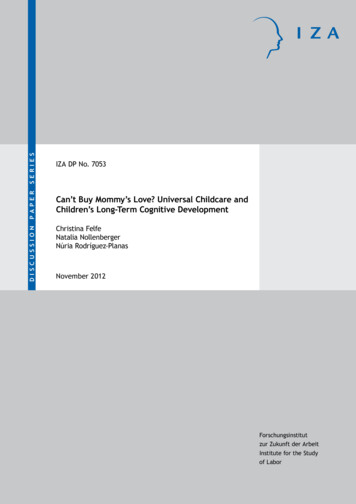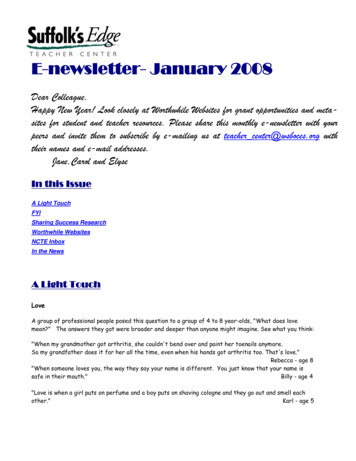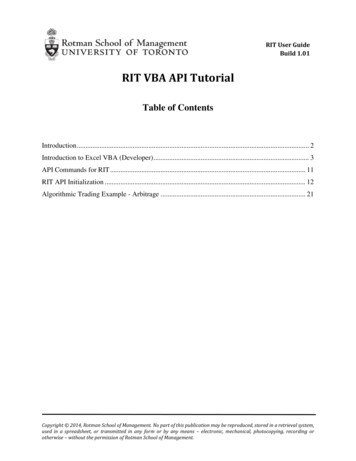
Transcription
SERIESPAPERDISCUSSIONIZA DP No. 7053Can’t Buy Mommy’s Love? Universal Childcare andChildren’s Long-Term Cognitive DevelopmentChristina FelfeNatalia NollenbergerNúria Rodríguez-PlanasNovember 2012Forschungsinstitutzur Zukunft der ArbeitInstitute for the Studyof Labor
Can’t Buy Mommy’s Love?Universal Childcare and Children’sLong-Term Cognitive DevelopmentChristina FelfeUniversität St. Gallen and CESifoNatalia NollenbergerUniversitat Autònoma de BarcelonaNúria Rodríguez-PlanasIZA, IAE-CSIC and Universitat Pompeu FabraDiscussion Paper No. 7053November 2012IZAP.O. Box 724053072 BonnGermanyPhone: 49-228-3894-0Fax: 49-228-3894-180E-mail: iza@iza.orgAny opinions expressed here are those of the author(s) and not those of IZA. Research published inthis series may include views on policy, but the institute itself takes no institutional policy positions.The IZA research network is committed to the IZA Guiding Principles of Research Integrity.The Institute for the Study of Labor (IZA) in Bonn is a local and virtual international research centerand a place of communication between science, politics and business. IZA is an independent nonprofitorganization supported by Deutsche Post Foundation. The center is associated with the University ofBonn and offers a stimulating research environment through its international network, workshops andconferences, data service, project support, research visits and doctoral program. IZA engages in (i)original and internationally competitive research in all fields of labor economics, (ii) development ofpolicy concepts, and (iii) dissemination of research results and concepts to the interested public.IZA Discussion Papers often represent preliminary work and are circulated to encourage discussion.Citation of such a paper should account for its provisional character. A revised version may beavailable directly from the author.
IZA Discussion Paper No. 7053November 2012ABSTRACTCan’t Buy Mommy’s Love? Universal Childcare andChildren’s Long-Term Cognitive Development *What happens to children's long-run cognitive development when introducing universal highquality childcare for 3-year olds mainly crowds out maternal care? To answer this questionwe exploit a natural experiment framework and employ a difference-in-difference approach.We find sizable improvements in children’s reading and math skills at age 15, as well as ingrade progression during primary and secondary school. Effects are driven by girls anddisadvantaged children.JEL Classification:Keywords:J13, I28universal high-quality childcare, long-term consequences, cognitive skillsCorresponding author:Núria Rodríguez-PlanasVisiting Research FellowIZAP.O. Box 724053072 BonnGermanyE-mail: rodriguez-planas@iza.org*The authors are grateful to Paul Devereux, Susan Dinarsky, Maria Fitzpatrick, Michael Lechner,Oskar Nordström Skans, Björn Öckert, Xavi Ramos, Uta Schönberg, Anna Sjögren, Anna Vignoles,Conny Wunsch, as well as participants from the V INSIDE-MOVE, NORFACE, and CReAM Workshopon Migration and Labor Economics, the III Workshop on Economics of Education “Improving Quality inEducation”, the CESifo Area Conference on the Economics of Education, as well as seminars at IFAU,University College Dublin, and University of St Gallen. Natalia Nollenberger acknowledges financialsupport from the Spanish Agency for International Development Cooperation from the Ministry ofForeign Affairs and Cooperation.
I.IntroductionAs Governments on both sides of the Atlantic are rolling back subsidizedchildcare, many worry about the potentially detrimental consequences for children'sdevelopment and long-term social and economic inequality. The evidence on theeffects of public childcare is, however, meager and focuses mostly on countries withhigh female labor force participation rates (such as the US and Canada), and withmany family-friendly policies (such as Scandinavian countries).1,2 In these countries,the introduction of universal childcare mainly led to a crowding out of private orinformal (non-maternal) care. The effects of such expansions on children’s skills arefound to be mostly positive, particularly among disadvantaged children.3 In contrast,a few studies find rather negative effects on children’s non-cognitive skills (Baker,Gruber and Milligan 2008, Loeb, et al. 2007, Magnuson, Ruhm and Waldfogel 2007).Nonetheless not much is known when the expansion of high-quality publicchildcare crowds out maternal care.4 Given that the direction and magnitude of theeffects depend crucially on the relative quality of the counterfactual care, the effects1Recent quasi-experimental evidence on universal childcare and child development includes Cascio(2009), Fitzpatrick (2008), Gormley and Gayer (2005) for the US; Baker, Gruber and Milligan (2008),for Canada, and Datta Gupta and Simonsen (2010), Drange, Havnes and Sandsør (2012) and Havnesand Mogstad (2011) for Scandinavian countries. To the best of our knowledge, Berlinski, Galiani andGertler (2009) and Dustmann, Raute and Schönberg (2012) are the exception as they investigate suchquestions for Argentina and Germany, respectively.2This literature complements substantial experimental or quasi-experimental research on the effects ofchildhood educational programs targeted explicitly at disadvantaged children (for an overview pleaserefer to Blau and Currie (2006)).3See Berlinski, Galiani and Gertler (2009), Gormley and Gayer (2005), and Fitzpatrick (2008) foreffects measured during preschool or primary school, Drange, Havnes and Sandsør (2012) for effectsmeasured at the end of mandatory schooling, and Cascio (2009), and Havnes and Mogstad (2011) foreffects measured during early adulthood.4Several recent studies evaluate the impact of maternal care on children's development exploitingparental leave expansions. They mostly do not find any significant effect on children's long-rundevelopment (Liu and Skans 2010, Rasmussen 2010, Baker and Milligan 2012, Dustmann andSchönberg 2012), with the exception of Carneiro, Løken and Salvanes (2010), who detect somepositive effects on educational and labor market outcomes at age 25 in Norway. It is important tohighlight that, in contrast with our paper, these papers focus on substituting public childcare bymaternal care at a much earlier age (usually within the first 15 months of the child) and the care modecrowded out can be manifold.1
of introducing public childcare when it crowds out private or informal care might notnecessarily coincide with the effects of introducing public childcare when it crowdsout maternal care.5 The latter scenario is, however, the more relevant scenario incountries with low female labor force participation and insufficient childcare supply.6Understanding the effects of introducing universal childcare in such a setting istherefore the main objective of this paper.More specifically, we use a naturalexperiment framework to analyze whether the introduction of high-quality publicchildcare for 3-year olds can significantly influence children's cognitive performanceby the end of mandatory schooling in a context in which the counterfactual care modeis mainly maternal care.We focus on an early 1990s reform in Spain, which led to a sizeable expansion ofpublicly subsidized full-time childcare for 3-year olds. Following the reform, overallenrollment in public childcare among 3-year olds increased from 8.5 percent in 1990to 42.9 percent in 1997 and to 67.1 percent in 2002. Importantly, this reform had amodest effect on maternal employment, did not affect fertility, and did not lead to acrowding out of private childcare (Nollenberger and Rodríguez-Planas 2011).Moreover, a crowding out of informal care was unlikely as most 3-year olds whosemothers worked prior to the reform were already enrolled in either public or privatechildcare. As a result, our effects have to be mainly interpreted as the effects ofsubstituting maternal care by public high-quality care. The income effect – either dueto a reduction in childcare costs (by crowding out private childcare arrangements) or5One recent paper discussing the relevance of the counterfactual care and the arising effectheterogeneity is the one by Felfe and Lalive (2012).6This includes but is not restrictive to Greece, Ireland, Italy, Japan, West Germany, Spain, Switzerland,and Turkey in the OECD alone.2
due to an increase in maternal earnings (by increasing maternal employment) arerather negligible.7The Spanish reform also included a federal provision regarding several qualityaspects (such as curriculum, group size, and staff skill composition). While thequality improvements were not exclusive to the children who were directly affectedby the expansion of public childcare, it is important to keep in mind that our findingshave to be interpreted as the consequences of introducing regulated high-quality care,which can also be compared to preschool targeted at 3-year olds. Thus, the reformunder study stands in stark contrast to other reforms such as the reforms in Canada,which implied moving middle class children from home care to relatively poor qualitycare (Baker, Gruber and Milligan 2008), or in Norway, which did not occur parallel toan overall improvement in childcare quality (Havnes and Mogstad 2011).Although the reform was national, the responsibility for implementing itspreschool component was transferred to the states.The timing of suchimplementation expanded over ten years and varied considerably across states. Weexploit this variation in the treatment intensity to isolate the impact of public childcareon children’s educational achievements in the long run. Our main empirical strategyis thus a difference-in-difference (henceforth, DiD) approach and is structured asfollows: we compare educational outcomes of children (at age 15) who were 3 yearsold prior to and after the reform from states where public childcare expandedsubstantially and states with a less pronounced increase in public childcare in theimmediate years after the reform.7In this aspect, our paper contrasts with that of Black et al. (2012) in which the authors are able toisolate the effects of childcare subsidies on both parental and student outcomes. Despite negligibleeffects of childcare subsidies on childcare use and parental labor force participation, they findsignificant positive effects on children's academic performance in junior high school, suggesting apositive income effect.3
The data used in this study stem from the 2003, 2006, and 2009 Programme forInternational Student Assessment (PISA). Children from PISA 2003 were born in1987 and hence, they were 4 years old when the reform was first implemented in1991.As a consequence, they were unaffected by the expansion of publiclysubsidized childcare for 3-year-old children. Children from PISA 2006 and 2009were born in 1990 and 1993, respectively, and thus they were affected by theexpansion of childcare at age 3.We first analyze the effects of the reform on maternal employment and privatechildcare enrollment in order to corroborate earlier findings of a small effect of thereform on maternal employment and no evidence of a crowding out of privatechildcare. Focusing on the effects of the reform on children's cognitive performanceat age 15, we find that universal childcare for 3-year olds led to a sizable increase inreading and math test scores, and a sizable decrease in the likelihood of falling behinda grade. More specifically, we find that the reform improved reading test scores atage 15 by 0.10-0.13 standard deviations and math test scores by 0.07 standarddeviations. In addition, the reform reduced the incidence of falling behind a grade by2.4 percentage points (or 50 percent) in primary school and by 3.2 percentage points(or 13 percent) in secondary school. Our results regarding reading test scores andfalling behind a grade in primary school are robust to the use of alternativespecifications and alternative identification strategies. Results regarding math testscores and falling behind a grade in secondary school are robust in 3 out of 7robustness tests. Finally, placebo estimates using month of birth as the dependentvariable support the hypothesis that our findings are not spurious.88Unfortunately, information on the state of residence is not available in the 2000 PISA data. Thus, weare unable to perform a placebo test using data prior to the actual time of the reform.4
Stratification with respect to gender reveals that girls mainly drive theachievement effects. This gender heterogeneity effect is in line with existing researchreporting larger benefits of public childcare for girls than for boys (Gathmann andSass 2012, Havnes and Mogstad 2011).Stratification with respect to parentaleducation also supports the findings of previous studies that public childcare isparticularly beneficial for children from disadvantaged backgrounds (Currie andThomas 1995, Datta Gupta and Simonsen 2010, Havnes and Mogstad 2011).Our paper stands in contrast to the existing research on the effects of publicchildcare on children’s development by focusing on a setting where public childcarecrowds out mainly maternal care, but neither private nor informal care. Our paper is,however, closer to Datta Gupta and Simonsen (2010) and to Drange, Havnes andSandsør (2012).Datta Gupta and Simonsen (2010) compare publicly providedchildcare at age 3 versus home care in Denmark. They find significant differences innon-cognitive skills among children cared for in public childcare vis-à-vis childrencared for in family day care, but no significant differences between children enrolledin preschool and children cared by their mothers, no matter the gender of the childand mother's level of education. However, their paper differs from ours in at leastthree important ways.First, they focus on non-cognitive skills (as opposed tocognitive skills). Second, their outcomes are measured at age 7 (as opposed to age15). Perhaps more importantly, their identification strategy only allows them to yieldcausal estimates for the effect of public childcare versus family day care, not,however, for the effect of public childcare versus maternal care. In a similar vein toour paper, Drange, Havnes and Sandsør (2012) focus on the effect of substitutingmaternal care by public childcare on children's cognitive outcomes at the end ofmandatory schooling. They find no significant effects. In contrast to our paper, their5
paper focuses on mandatory preschool provided mainly to disadvantaged children atage 6. Thus arising differences between their and our results might stem from effectheterogeneity with respect to age and potential gains from childcare. On the onehand, younger children might benefit more from a program which (like ours) focuseson learning through play. On the other hand, as the authors explain in their paper, thefact that access to childcare was already substantial prior to the reform suggests thatparents sort relatively efficiently into the existing kindergarten programs, so thatchildren who are not in such programs in fact may opt out partly because they willbenefit little from them.The paper is organized as follows. The next section provides an overview of theinstitutional background. Sections 3 and 4 present the empirical strategy and the data,respectively. Section 5 presents the main results, the sensitivity analysis and theheterogeneity analysis. Section 6 concludes.II.Background InformationInstitutional BackgroundIn Spain, female labor force participation rates are among the lowest in the OECD. In1990, before the reform under analysis came into force, the Spanish female laborforce participation rate was 43 percent, far behind the 70 percent of the US, 69percent of Canada, 73 percent in Norway and 78 percent of Denmark (the countrieson which other studies analyzing childcare expansions have focused). In addition, theemployment gap due to motherhood amounted to 10 percentage points (GutierrezDomenech 2005). Reasons for such a scenario are manifold. In the late 1980s andearly 1990s, Spain was not a family-friendly country for working parents (andespecially working mothers) as reflected by its low levels of social assistance to6
families (Adserà 2004), one of the shortest maternity leaves in Europe (Ruhm 1998),an extremely low incidence of part-time work (only 8 percent of all jobs in 1990), aswell as a rigid labor market with many jobs in the service sectors having a split shiftfrom 9 am to 2 pm and from 5 to 8 pm (Amuedo-Dorantes and de la Rica 2009).Moreover, Spain was a traditional country with low participation of men in householdproduction (Bettio and Villa 1998, de Laat and Sevilla-Sanz 2011). Consistent withthis, only half of all married women aged 18 to 45 were working or looking for a jobin 1992, and among those not participating in the labor market, 45 percent reportedfamily responsibilities as their main reason.9School and Preschool Prior to the ReformMandatory schooling in Spain begins at age 6. However, preschool for 4- and 5-yearolds is also offered at the premises of primary schools from 9 am to 5 pm (regardlessof school ownership status). Once a primary school offers places for 4-year olds,parents who wish to enroll their children in that particular school will do so when thechild turns 4 years old as the chance of being accepted by the school may decreaseconsiderably a year later (as priority for enrollment of 5- and 6-year olds is given tothose children already enrolled in that particular school when they were 4 years old).As a consequence, enrollment rates for 4- and 5-year olds in the late 1980s were 94and 100 percent, respectively.Primary and secondary schooling is either public or private.10 Public schools arefree of charge, except for school lunch, which costs about 100 per child per month.9Estimated by the authors based on micro data from the 1992 Spanish Labor Force Survey.About one third of children in primary school in Spain are enrolled in private schools. In this paper,private schools refer to "escuelas concertadas" for which the government subsidizes the staff costs(including teachers). There are a very small number of private schools, which tend to be foreignschools (such as the French, Swiss or American schools), and cost two to three times more than theaverage "escuela concertada".107
Private school costs are higher - between 250 and 350 euros per child per month(including lunch).At the beginning of the 1990s, childcare for children 0- to 3-years old was ratherscarce, predominantly private, and also quite expensive (on average it cost between300 and 400 euros per child per month - including lunch). In contrast with someScandinavian countries and the US, family day care, where a reduced number ofchildren are under the care of a certified carer in her house, is practically non-existent.In Spain, children under 4 are either in formal (public or private) childcare or withtheir mother (or grandmother). Unfortunately, information on grandmother care isunavailable. As a consequence, this paper considers motherly care as equivalent tocare provided by the nuclear family.The ReformIn 1990, Spain underwent a major national education reform (named LOGSE) thataffected preschool, primary and high school.The focus of our study is on thepreschool component of this reform, which consisted of regulating the supply and thequality of preschool, and its implementation began in the school year 1991/92. Theprimary and secondary school component of the reform increased mandatoryschooling by two years (from age 14 to age 16) starting school year 1996/97. Inaddition, it established that primary school would end at age 12 (instead of age 14).Our analysis isolates the effect of the preschool component by focusing on childrenborn between 1987 and 1993 who were all affected by the primary and secondaryschool component but not necessarily by the preschool component.The LOGSE divided preschool into two levels: the first level included children upto 3 years old, and the second level included children 3 to 5 years old. While notintroducing mandatory attendance, the government began regulating the supply of8
places for 3 year olds. Prior to the LOGSE, free universal preschool education hadonly been offered to children 4 to 5 years old in Spain. After the LOGSE, preschoolplaces for 3 year olds were offered within the premises of primary schools and wererun by the same team of teachers. This implied that childcare for 3 year olds operatedfull-day (9 am to 5 pm) during the five working days and followed a homogeneousand well-designed program. With the introduction of the LOGSE, schools had toaccept children in September of the year the child turned 3 whenever parents askedfor admission if places were available. Available preschool places were allocated tothose who had requested admission by lottery (regardless of parents’ employment,marital status, or income).As explained earlier, although enrollment was notmandatory, it was necessary to ensure a place in the parents' preferred school choice.As a consequence, childcare enrollment among 3-years-old children went frommeager to universal in a matter of a decade.11 Between the academic years 1990/91and 2002/03 the number of 3-years-old children enrolled in public preschool centersincreased extraordinarily from 33,128 to 238,709. This represented an increase in thepublic enrollment rate of 3-year olds by more than 58.6 percentage points, from 8.5percent to 67.1 percent.12Federal funding for preschool and primary educationincreased from an average expenditure of 1,769 per child in 1990/91 to 2,405 in1996/97 (both measured in 1997 constant euros), implying a 35.9 percent increase ineducation expenditure per child.13Apart from regulating the supply of public childcare, the LOGSE also providedfederal provisions for the first time in Spain regarding educational content, group size,11Unfortunately we only have information on enrollment rates and not on actual supply rates for 3-yearolds. In the context of rationed supply, enrollment rates should, however, resemble coverage ratesquite closely.12These figures exclude the Basque Country, Navarra and Ceuta and Melilla as they are not included inour analysis.13Unfortunately data disaggregated at the preschool level is not available.9
and staff skill composition regardless of ownership status for children 3 to 5 years old.Psycho-educational theories such as constructivism (put forward by Jean Piaget, andLev Vygotski) and progressive education (based on Célestin Freinet and OvideDecroly) served as a guideline for the design of the curriculum. There was a strongemphasis on play-based education, group play, learning through experiencing theenvironment, problem solving and critical thinking. The particular objectives ofpreschool education focused on: (1) personal development where the child masters itsown body and understands its own movement possibilities; (2) emotionaldevelopment where the child interacts with others in a variety of context andcommunication modes; (3) social development where the child forms goodrelationships with adults and peers and understands that people have different needs,views, cultures and beliefs; and (4) personal autonomy in the child's usual activities(LOGSE; 3 October 1990). While the pedagogical movements behind the LOGSEare close to those in Scandinavian countries, they have been viewed as an alternativeto the test-oriented instruction legislated by the No Child Left Behind educationalfunding act in the US or the reception class in the UK.In addition, the LOGSE established the maximum number of students per class tobe 20 for 3-year olds and 25 for 4- and 5-years old. It is important to point out thatclasses are grouped based on the year children were born and thus, are not mixed inages.14 Finally, the LOGSE required preschool teachers to have a college degree inpedagogy – a requirement previously only enforced for teachers of 4- and 5-year olds.The quality improvements affected all children enrolled in preschool (that is, 3-,4- and 5- year olds). As a consequence, our analysis should be able to isolate theeffect of the expansion of high-quality public childcare from overall quality14As a consequence, we ought not to worry about potential spillover effects from incoming 3-year oldchildren on 4-year old children. This point is important as age-mixed groups would represent a threat toour estimation methodology.10
improvements of preschool education of 4- and 5-year olds (all cohorts under studywere affected by the improved quality of preschool for 4- and 5-year olds).Despite being a national law and being financed nationwide, the responsibility ofimplementing the expansion of public preschool slots was transferred to the states.The timing of such implementation expanded over ten years and varied considerablyacross states frequently for arbitrary reasons. Implementation lags arose largely dueto a scarcity of qualified teachers and constraints on classroom space in existingprimary schools (El País October 3rd 2005). In fact, the ratio children per classroomin childcare centers (public and private for children age 0 to 5 years old) was 24.1among treatment states in 1990 versus 27.2 among control states.15 Moreover, aninitially higher level of private childcare facilities in treatment states in comparison tocontrol states (see Section III for more details) might have provided the necessaryknow-how to implement childcare facilities at a faster speed.Our empirical strategy exploits the differences in the timing of implementationacross states. Details on our empirical strategy and concerns as to whether there areany further systematic pre-reform differences or differential trends parallel to theexpansion of childcare across states that might bias our results are further discussed inthe next section.III.Empirical SpecificationIdentificationOur empirical strategy follows that of Havnes and Mogstad (2011). We use a DiDstrategy which compares the cognitive development at age 15 of children who were 3years old before and after the reform in states where childcare expanded a lot (the15Calculated by the authors based on statistics from the Spanish Ministry of Education.11
treatment group) and in states where the increment in childcare coverage was lesspronounced immediately after the reform (the control group). To determine the cutoff needed to define which states belong to the treatment and the control group, wefollow Havnes and Mogstad (2011), and order states according to their percentagepoint increase in public childcare enrollment of 3-year olds in the immediate yearsafter the reform, to be precise between 1990 and 1993. By choosing the initial yearsafter the reform, we aim at capturing the differential expansion in public childcare dueto a slackening of initial constraints, and not due to differences in underlyingpreferences or demand. We then separate the sample at the median. Those states thatexperienced an increase in public childcare enrollment above the median belong toour treatment group whereas those with an increase under the median belong to ourcontrol group.Figure 1 displays the average increase in public childcare coverage for 3-year oldsfor the treatment and the control groups from 1987/88 to 2002/03. Prior to thereform, there are few differences, on average, between treatment and control groups:in 1990/91 the enrollment rate of publicly available preschool places for 3-year oldsamounted to 9.9 percent in the treatment group and to 7.4 percent in the controlgroup. Yet, families living in treatment states experienced a much stronger initialincrease in preschool places than families living in control states. For instance,among states in the treatment group, the public enrollment rate for 3-year olds rosefrom 9.9 percent in school year 1990/91 to 44.0 percent in the school year 1993/94and 57.1 percent in school year 1996/97. In comparison, the public enrollment ratefor 3-year olds in the control group increased from 7.4 percent to 15.3 percent in1993/94 to 29.4 percent in school year 1996/97. Figure 1 also shows that while thereare dramatic differences in the initial expansion of public childcare, the control states12
fully catch up within a decade. Figure 2 provides evidence that, in contrast with theobserved differences in public childcare, trends in private childcare are remarkablysimilar across the treatment and control group. As a result, our study compares statesthat differ distinctly in terms of initial changes in public childcare coverage, not,however, in terms of long-run trends or potential demand for childcare.Table 1, Panel B.2, provides us with an overview of pre- and post-reformdifferences in several socio-economic features between treated and control states,including parents' educational level. Although treatment states performed better interms of several socioeconomic indicators than control states, the differences are notstatistically significant. Moreover, we find no substantial differences between pre- orpost-reform trends (see Figure A.1 in the Appendix). As such, if any, differences instate features do not represent a threat to our identification strategy. Still, we controlfor pre-reform state characteristics in our preferred specification.Moreover, weadditionally test the robustness of our results to these differences by restricting oursample to only states that were very similar prior to the reform in terms of suchobservables (see Section V for details).ImplementationOur basic DiD model, estimated by OLS over the sample of children from PISA2003, 2006 and 2009, can be expressed as follows:16Yijt γ1Treat i γ 2Cohort90 γ 3Cohort93 θ1 (Treat i * Cohort90) θ 2 (Treat i * Cohort93) X i' β Z 'jδ ε ijt(1)where Yijt measures the educational outcome a child i achieves in year t living in state j, Treati is a binary variable indicating whether or not child i
mothers worked prior to the reform were already enrolled in either public or private childcare. As a result, our effects have to be mainly interpreted as the effects of substituting maternal care by public high-quality care. The income effect - either due to a reduction in childcare costs (by crowding out private childcare arrangements) or










